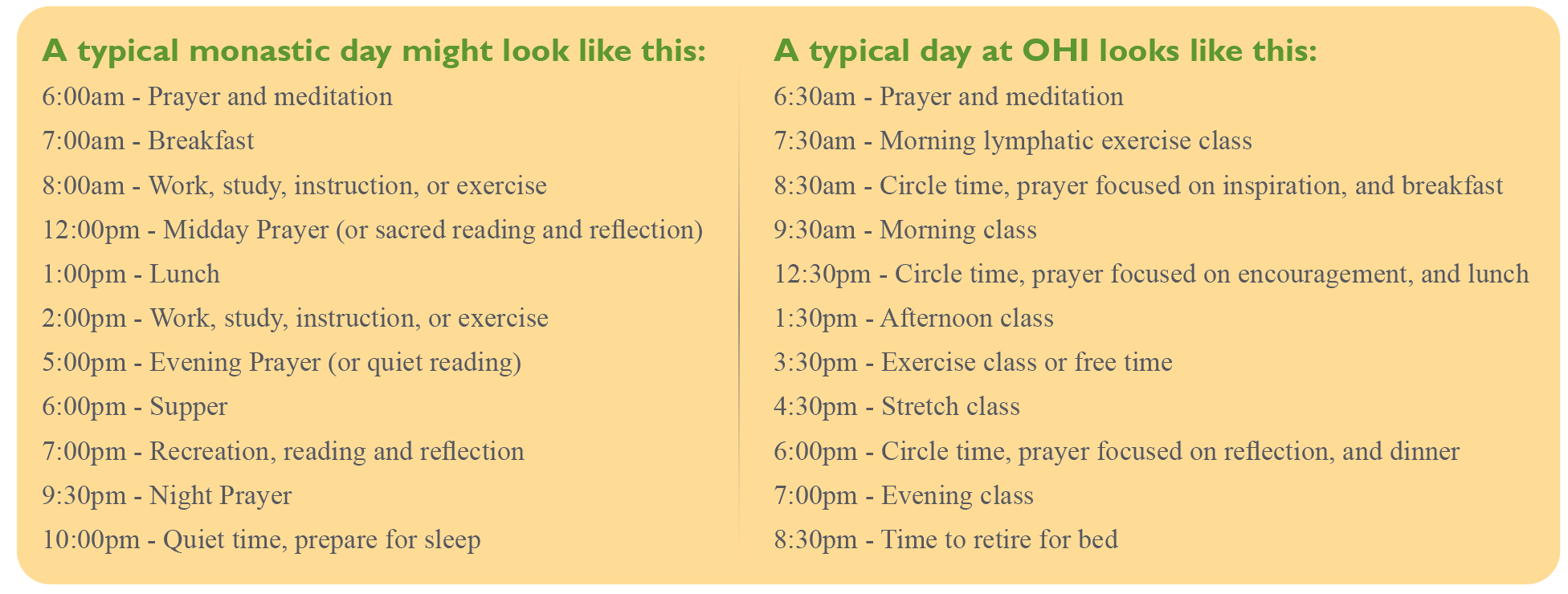In last week’s article, we talked about the importance of following a daily rhythm. This week, we expand on how to establish a schedule that supports your natural circadian rhythm. Here is part 2 of our 2-part series…
In our busy, modern, 24-hour society, schedules can be unpredictable; jobs started must be completed, impatient customers are waiting, and we’re forced to be flexible. This makes it easy to throw your natural rhythms out of balance. Here at OHI we have a solution to helping you return your daily rhythms back to their regular tempo. We follow a daily and weekly rhythm, Benedictine Monastic Rhythm, that organizes the monastic day around periods of communal and private prayer, manual labor, spiritual reading and sleep which in modern times has been replaced with instruction.
Monastic rhythm is all about ensuring God is glorified in all things we do. According to Strategic Monk, Greg Richardson, a monk’s day consists of “time for reflection and labor, worship and rest, learning and thinking.”
The monastic way of life is centuries old; its traditions began with the solar day, and it follows our natural circadian rhythm. When the time to stop work arrives, a monk will put down his tools, he doesn’t have a deadline which forces him to continue until the job is done. In days past most people’s lives followed a circadian rhythm. Farmers rose with the sun, and worked until the sun set. Workers in factories, skilled trades, and some offices still follow a similar rigid schedule; even if it’s only 9 to 5. However, in today’s rapidly changing world, and the rise of the gig economy, it becomes challenging to keep the symmetry in our workday. When we lose touch with the rhythms of life, we lose valuable opportunities to rest and reflect. As author, Matthew Kelly, observed, “If you don’t break from the tensions of daily living, they will break you.”
An important aspect of the monastic day is that it gives you time for pauses. A pause might be a time to phone a friend, listen to music, go for a short walk, be quiet with your thoughts, take deep breaths, meditate, or take a power nap. Pauses are times for deep relaxation – times where you are not working – when you can enjoy the moment fully… and allow your brain to rest.
At OHI we follow in the monastic tradition. Each day is designed to ensure that your body’s natural rhythm is restored. Our 21 day holistic program is formulated to bring harmony to your body, mind, and spirit. The first week is the most challenging because you are breaking free from your disrhythmic lifestyle. You will shed old habits and develop new ones as you learn how to cleanse your body, quiet your mind, and renew your spirit. Our classes will enable you to detox your body, your emotions, and your thoughts. You’ll learn meditation techniques to manage stress, release tension, and control pain. You will enjoy the right balance between scheduled activities (classes, meals, exercise) and free-time (optional treatments, journaling, relaxation), so that by the end of week three you will feel amazing!

The Complete Guide to the Science of Circadian Rhythms by Jeremy Berger, observer.com, December 29, 2017
Leading Like a Monk: Finding Our Rhythms by Greg Richardson, patheos.com, April 13, 2017
Monastic rhythm of life by Ian Adams, churchtimes.co.uk, February 22, 2011
What Are Biological Rhythms? by Amber Erickson Gabbey and Rachel Nall, healthline.com, November 4, 2016
At Optimum Health Institute, we teach you all about establishing a daily schedule that supports your natural circadian rhythm.
During your visit, our caring team can help you achieve your physical, mental, emotional and spiritual goals for optimal health. Visit our website at www.optimumhealth.org, and call us at (800) 588-0809 to make your reservation.

